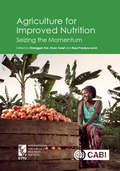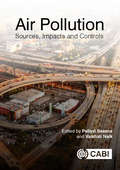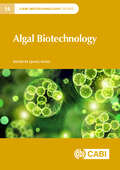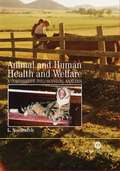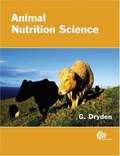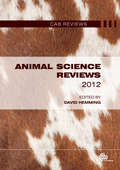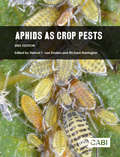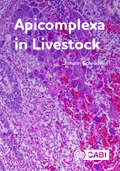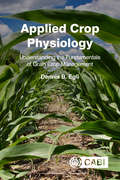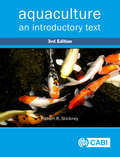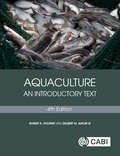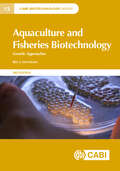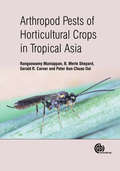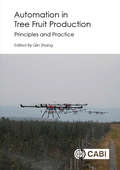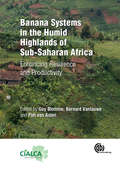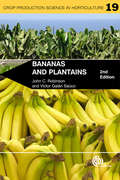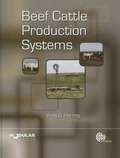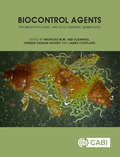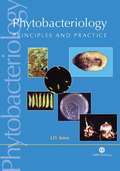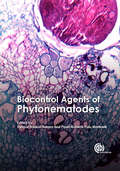- Table View
- List View
Agriculture for Improved Nutrition: Seizing the Momentum
by Noora-Lisa Aberman Mathew Abraham Akhter U. Ahmed Summer Allen Suresh Chandra Babu Ekin Birol Anne Bossuyt Howarth E. Bouis Kevin Chen Gerald F. Jr Olivier Ecker Dr Jessica Fanzo Aulo Gelli Julie Ghostlaw Stuart Gillespie Daniel O. Gilligan Lawrence Haddad Derek Headey Mar Maestre Hazel Malapit William Masters Ruthie Musker Nicholas Nisbett Rajul Pandya-Lorch Prabhu L Pingali Daniel J. Raiten Marie T. Ruel Amy Saltzman Zimeiyi Wang Sivan YosefAgriculture's vast potential to improve nutrition is just beginning to be tapped. New ideas, research, and initiatives developed over the past decade have created an opportunity for reimagining and redesigning agricultural and food systems for the benefit of nutrition. To support this transformation, this book reviews the latest findings, results from on-the-ground programs and interventions, and recent policy experiences from countries around the world that are bringing the agriculture and nutrition sectors closer together. Drawing on IFPRI's own work and that of the growing agriculture-nutrition community, this book strengthens the evidence base for, and expands our vision of, how agriculture can contribute to nutrition. Chapters cover an array of issues that link agriculture and nutrition, including food value chains, nutrition-sensitive programs and policies, government policies, and private sector investments. By highlighting both achievements and setbacks, Agriculture for Improved Nutrition seeks to inspire those who want to scale up successes that can transform food systems and improve the nutrition of billions of people. Key features: -Investigates the latest evidence on the relationship between agriculture and nutrition. -Includes insights from internationally renowned researchers. -Presents data from real-world settings that is highly relevant to the challenges faced by developing countries. This book is ideal for policy-makers, practitioners, and students working in agriculture, international development and nutrition.
Air Pollution: Sources, Impacts and Controls
by Pallavi Saxena Professor Vaishali Naik Amit Awasthi Sangeeta Bansal Monojit Chakraborty Naveen Chandra Arti Choudhary Manisha Gaur Vineet Goswami Tarun Kumar Gupta Harpreet Kaur Priyanka Kulshrestha Amit Kumar Ruchi Kumari Chinmay Mallick Renu Masiwal Vandana Maurya Neha Mishra Prashant Rajput Anuradha Shukla Gyanesh Kumar Singh Ravi Prakash Singh Ruchi Singh Saumya Singh Saurabh Sonwani Shani TiwariAir pollution has become a major global issue due to rapid industrialization, human population growth and increasing urbanization. The various sources of atmospheric pollutants, both those created by human activity and those from natural physical and biological processes, have become the focus of much scientific research and analysis. An understanding of how these many pollutants are affecting air quality is essential in order to design strategies to mitigate them. Written by a team of international experts, this book aims to provide a broad overview of the issues surrounding air pollution and how to control and monitor pollution levels. Beginning with a brief background on the subject, the book moves on to discuss global emissions, with an emphasis on megacities and their effects. Possible pollution control measures and methods of air pollution measurement and modelling are also explored. The book ends with descriptions of the various indices used for assessing air quality with a focus on human health impacts, and a discussion on policy making to control air pollution. The book will be useful to students of environmental science and atmospheric science, as well as environmental consultants and researchers interested in air quality . Key Features: Comprehensive introduction to the primary causes of air pollution today with an emphasis on growing urban populations and megacities Discusses both anthropogenic and biogenic emissions and their effects on human health and the environment Gives an overview of indices used today for assessing air quality and describes current methods for air pollution monitoring and modelling Discusses new technologies for mitigating the effects of air pollution and policy making for implementation of controls
Air Pollution: Sources, Impacts and Controls
by Amit Awasthi Sangeeta Bansal Monojit Chakraborty Naveen Chandra Arti Choudhary Manisha Gaur Vineet Goswami Tarun Kumar Gupta Harpreet Kaur Priyanka Kulshrestha Amit Kumar Ruchi Kumari Chinmay Mallick Renu Masiwal Vandana Maurya Neha Mishra Professor Vaishali Naik Prashant Rajput Anuradha Shukla Gyanesh Kumar Singh Ravi Prakash Singh Ruchi Singh Saumya Singh Saurabh Sonwani Shani TiwariAir pollution has become a major global issue due to rapid industrialization, human population growth and increasing urbanization. The various sources of atmospheric pollutants, both those created by human activity and those from natural physical and biological processes, have become the focus of much scientific research and analysis. An understanding of how these many pollutants are affecting air quality is essential in order to design strategies to mitigate them. Written by a team of international experts, this book aims to provide a broad overview of the issues surrounding air pollution and how to control and monitor pollution levels. Beginning with a brief background on the subject, the book moves on to discuss global emissions, with an emphasis on megacities and their effects. Possible pollution control measures and methods of air pollution measurement and modelling are also explored. The book ends with descriptions of the various indices used for assessing air quality with a focus on human health impacts, and a discussion on policy making to control air pollution. The book will be useful to students of environmental science and atmospheric science, as well as environmental consultants and researchers interested in air quality . Key Features: Comprehensive introduction to the primary causes of air pollution today with an emphasis on growing urban populations and megacities Discusses both anthropogenic and biogenic emissions and their effects on human health and the environment Gives an overview of indices used today for assessing air quality and describes current methods for air pollution monitoring and modelling Discusses new technologies for mitigating the effects of air pollution and policy making for implementation of controls
Algal Biotechnology (CABI Biotechnology Series)
by Yahui Bo Gao Chen Lei Chen Zhenfan Chen Zixi Chen Pengfei Cheng Feng Ge Jiameng Guo Sanjay Gupta Xiahui Hao Qingfang He Fan Hu Hanhua Hu Krishna Kumar Jaiswal Hu Jin Vinod Kumar Anping Lei Anna I. Kurbatova Chao Li Yanhua Li Hanzhi Lin Lu-Ning Liu Qiong Liu Yandu Lu Anastasios Melis Yufang Pan Vishal Rajput Roger Ruan Shengzhou Shan Kaitlin Simmons Xiaotong Song Xinyu Song Adamu Yunusa Ugya Mikhail S. Vlaskin Chun Wang Jiangxin Wang Jin Wang Xiaojun Yan Wenxiu Yin Weiwen Zhang Xiangxiang Zhang Xu Zhang Yu-Zhong Zhang Long-Sheng Zhao Quanyu Zhao Chengxu Zhou Yali Zhu Zhu Zhen Tian Jing Cao XupengAlgae are sunlight-driven cell factories, and can efficiently absorb CO2 and convert light energy to chemical energy such as lipid, starch and other carbohydrates and release O2. Algal feedstock is a promising resource for bioproduct production, given its high photosynthetic efficiency for producing biomass compared to conventional crops. Microalgae can be used for flue-gas and wastewater bioremediation. This book highlights recent breakthroughs in the multidisciplinary areas of algal biotechnology and the chapters feature recent developments from cyanobacteria to eukaryotic algae, from theoretical biology to applied biology. It also includes the latest advancements in algal-based synthetic biology, including metabolic engineering, artificial biological system construction and green chemicals production. With contributions by leading authorities in algal biotechnology research, it is a valuable resource for graduate students and researchers in the field, and those involved in the study of photosynthesis and green-cell factories.
Animal and Human Health and Welfare
by Lennart NordenfeltScientists within human and animal science have extensively discussed the philosophy of medicine, but never have both sides communicated on their concepts of health, quality of life and welfare, with each other. This book aims to help clarify the difficult but central notions of health and welfare by comparing the human and animal variants of these concepts. Split into three parts this book starts by presenting a background of some of the major theories of human health and welfare, followed by a detailed discussion of theories on animal welfare and health. While the final part of the book tests a comprehensive conceptual framework of a holistic kind, which focuses on the individual's ability to achieve its vital goals.
Animal Nutrition Science
by Gordon DrydenWritten for senior undergraduate and graduate students, Animal Nutrition Science introduces the fundamental topics of animal nutrition, in a treatment which deals with terrestrial animals in general. Addressing a wider range of topics than the standard animal nutrition texts, the subjects covered include nutritional ecology and the evolution of feeding styles, nutrients (including minerals, vitamins and water) and their functions, food composition and methods of evaluating foods, mammalian and microbial digestion and the supply of nutrients, control and prediction of food intake, quantitative nutrition and ration formulation, methods of investigating nutritional problems, nutritional genomics, nutrition and the environment, and methods of feed processing and animal responses to processed foods. The many references provide the scientific basis for the text, and give signposts for the reader to extend their enquiry in topics of interest.
Animal Science Reviews 2012
by David HemmingAnimal Science Reviews 2012 provides scientists and students with analysis of key topics in current research including breeding, animal behaviour, zoonotic diseases and environment. Experts such as Mike Stear, James France, Phillip Klesius and Frederick Silversides give essential overviews of their fields. Originally published online in CAB Reviews, this volume makes available in printed form the reviews in animal science published during 2012.
Aphids as Crop Pests
by Helmut F. Emden Richard HarringtonAphids are among the major global pest groups, causing serious economic damage to many food and commodity crops in most parts of the world. This revision and update of the well-received first edition published ten years ago reflects the expansion of research in genomics, endosymbionts and semiochemicals, as well as the shift from control of aphids with insecticides to a more integrated approach imposed by increasing resistance in the aphids and government restrictions on pesticides. The book remains a comprehensive and up-to-date reference work on the biology of aphids, the various methods of controlling them and the progress of integrated pest management as illustrated by ten case histories. Helmut van Emden is Emeritus Professor of Horticulture at the University of Reading, UK. He has researched on aphids for over 50 years and has wide international experience, including in the tropics. Richard Harrington retired in 2015 as Head of the Rothamsted Insect Survey, with which he worked for 36 years on aphid monitoring and forecasting. He led the EU project "EXAMINE" (Exploitation of Aphid Monitoring In Europe) which brought together colleagues involved in aphid monitoring throughout Europe and beyond.
Aphids as Crop Pests
by Caroline S Awmack Sebastiano Barbagallo Chris Bass James R Bell A Nicholas Birch Roger Blackman Thierry Brévault Jacques Brodeur Toby J Bruce Mauricio G Chang Giuseppe Massimino Cocuzza Rosemary Rosemary Piero Cravedi T G Davies Charles-Antoine Dedryver Jean-Philippe Deguine Ian Denholm Gregor Devine Alan Devonshire Alan M Dewar Angela E Douglas Victor Eastop Owain Edwards Frédéric Fabre Alberto Fereres Linda M Field Stan Finch Stephen P Foster Michael P Garratt Robert T Glinwood Fiona L Goggin Geoff Gurr Dr Ann E. Hajek Thierry Hance Jim Hardie Udo Heimbach Dr George E. Heimpel Gemma L Hough Maurice Hullé Rufus Isaacs Dr Michael E. Irwin Dr Gail E. Kampmeier Fatemeh Kohandani-Tafresh Shinkichi Komazaki Christophe Lacomme Simon R Leather Samuel G Leigh Hugh D Loxdale Dr Manfred Mackauer Dr Robert R Martin J P Michaud Françoise Munaut Dr Xinzhi Ni Dr Judith K. Pell Jan Pettersson John A. Pickett Jon Pickup Jean-Sébastien Pierre Hans-Michael Poehling Jeremy Pritchard Sharron S. Quisenberry Pierre J. Silvie John J. Sloggett Mark Stevens Denis Tagu Mark Tatchell Thomas Thieme W Fred Tjallingii Jason M Tylianakis Laura H Vickers Christoph Vorburger Susan E Webb Martin S Williamson Steve Wratten Jing-Jiang ZhouAphids are among the major global pest groups, causing serious economic damage to many food and commodity crops in most parts of the world. This revision and update of the well-received first edition published ten years ago reflects the expansion of research in genomics, endosymbionts and semiochemicals, as well as the shift from control of aphids with insecticides to a more integrated approach imposed by increasing resistance in the aphids and government restrictions on pesticides. The book remains a comprehensive and up-to-date reference work on the biology of aphids, the various methods of controlling them and the progress of integrated pest management as illustrated by ten case histories. Helmut van Emden is Emeritus Professor of Horticulture at the University of Reading, UK. He has researched on aphids for over 50 years and has wide international experience, including in the tropics. Richard Harrington retired in 2015 as Head of the Rothamsted Insect Survey, with which he worked for 36 years on aphid monitoring and forecasting. He led the EU project "EXAMINE" (Exploitation of Aphid Monitoring In Europe) which brought together colleagues involved in aphid monitoring throughout Europe and beyond.
Apicomplexa in Livestock
by Johann SchröderThe Apicomplexa is a globally prevalent group of parasitic protozoa that cause disease, from malaria in humans to livestock diseases such as coccidiosis, babesiosis (Red Water, Tick Fever) and East Coast Fever. With significant economic impacts, a number of Apicomplexa are also zoonotic, leading to grave potential public health consequences. Infection prevention efforts by immunisation or management of arthropod vector infestation have not been universally successful, and can have knock-on effects such as pollution of the environment and human food chain, and development of insecticidal or acaricidal resistance. This book highlights the similarities and differences between the various Apicomplexa infections, identifying those of greatest significance and suggesting sustainable approaches to better manage their impact on livestock productivity. The book: Reviews Australian livestock as a case study, but highlights global applications, biosecurity concerns and lessons learned; Covers Apicomplexa-caused disease across cattle, pigs, poultry and sheep; Considers human health and environmental impacts, and how sustainable management methods can better outcomes for all. Suitable for researchers and students of veterinary parasitology and related disciplines, this book is a valuable resource covering this important set of parasites.
Applied Crop Physiology: Understanding the Fundamentals of Grain Crop Management
by Dennis EgliThis book presents a simple, straightforward discussion of the principles and processes involved in the production of grain yield by agronomic crops, and how these processes underlie and influence management decisions. The focus is on grain crops, principally maize and soybean, although the general principles apply equally well to cereals, grain legumes and oil crops. Management decisions define all cropping systems - what (crop species, variety), where (climate), when (planting date), and how (row spacing and population density) are the fundamental choices. Knowledge of the fundamental processes responsible for plant growth and the accumulation of yield simplifies the decision-making process and leads to improved management decisions, higher grain yields, and cropping systems that are efficient, resilient and sustainable. The contents include: · Basic plant growth processes e.g. photosynthesis, respiration, evapotranspiration · Growth and production of yield · Crop management - seed quality, variety selection, plant date, row spacing · Crop production in the future - climate change, GMOs, precision data and new crops Intended for researchers in crop science, agronomy and plant science, and crop production practitioners, this book will enable readers to make better, more informed management decisions; decisions that will help maintain a well-fed world in the future.
Aquaculture: An Introductory Text
by Robert R StickneyProviding a broad and readable overview of the subject, this updated third edition of Aquaculture: An Introductory Text covers issues associated with sustainable aquaculture development, culture systems, hatchery methods, nutrition and feeding of aquaculture species, reproductive strategies, harvesting and many other topics. While its main focus is on the culture of fish, molluscs and crustaceans for food, the book also covers other forms of aquaculture, such as the production of seaweeds, recreational fish and ornamental species, and live foods such as algae and rotifers that are used to feed larval shrimp and marine fish. Thoroughly updated and revised, the third edition of this essential textbook now includes: - Increased coverage of species under culture - Increased scope to cover species for enhancement, recreational fishing, commercial fishing and aquaria - Newly developed culture systems - Information on predictive impacts of climate change - Updated aquaculture production statistics Aquaculture remains one of the most rapidly growing agricultural disciplines and this book remains an essential resource for all students of aquaculture and related disciplines.
Aquaculture: An Introductory Text
by Robert R Stickney Delbert Gatlin IIIProviding a broad and readable overview of the subject, this updated fourth edition of Aquaculture: An Introductory Text covers issues associated with sustainable aquaculture development, culture systems, hatchery methods, nutrition and feeding of aquaculture species, reproductive strategies, harvesting, and many other topics. While its main focus is on the culture of fish, molluscs and crustaceans for food, the book also covers other forms of aquaculture, such as the production of seaweeds, recreational fish and ornamental species, as well as live foods, such as algae and rotifers that are used to feed larval shrimp and marine fish. Thoroughly updated and revised, this essential textbook now includes: - Increased coverage of open-ocean cage culture and sea lice issues with salmon culture; - Coverage of the significant progress made in nutrition, including the move away from fishmeal as protein and fish oil as lipids in feed; - Information on biofloc technology uses, predictive impacts of climate change, probiotics, and the impact of COVID-19 on the aquaculture community; - Updated aquaculture production statistics and lists of approved anaesthetics. Aquaculture remains one of the most rapidly growing agricultural disciplines, and this book remains an essential resource for all students of aquaculture and related disciplines
Aquaculture, 3rd Edition
by Robert R. StickneyProviding a broad and readable overview of the subject, this updated third edition of Aquaculture: An Introductory Text covers issues associated with sustainable aquaculture development, culture systems, hatchery methods, nutrition and feeding of aquaculture species, reproductive strategies, harvesting and many other topics. While its main focus is on the culture of fish, molluscs and crustaceans for food, the book also covers other forms of aquaculture, such as the production of seaweeds, recreational fish and ornamental species, and live foods such as algae and rotifers that are used to feed larval shrimp and marine fish. Thoroughly updated and revised, the third edition of this essential textbook now includes: - Increased coverage of species under culture - Increased scope to cover species for enhancement, recreational fishing, commercial fishing and aquaria - Newly developed culture systems - Information on predictive impacts of climate change - Updated aquaculture production statistics Aquaculture remains one of the most rapidly growing agricultural disciplines and this book remains an essential resource for all students of aquaculture and related disciplines.
Aquaculture and Fisheries Biotechnology: Genetic Approaches (CABI Biotechnology Series)
by Rex DunhamThe genetic improvement of fish for aquaculture and related fisheries has seen huge advances over recent years. Building upon the previous two editions of Aquaculture and Fisheries Biotechnology: Genetic Approaches, this 3rd edition offers a presentation of traditional selective breeding, modern genetic biotechnology, genomics, gene transfer and gene editing, and the latest developments in genetic biotechnology such as epigenetics, xenogenesis and genome-wide association study coupled with commercial application, the impact of government regulation and expectations for the future. It provides a firm grounding in relevant aspects of classical genetics, before focusing on particular aspects such as sex reversal and breeding as applied in aquaculture and fisheries. It also explores how more recent molecular genetics, genomics and biotechnology techniques can be used and combined in improvement programmes for fish and aquaculture species. A glossary explains the latest terminology used in biotechnology and genetics. This book will be useful for research scientists and students in marine biotechnology, aquaculture biotechnology, and fish genetics and breeding.
Arthropod Pests of Horticultural Crops in Tropical Asia
by Professor Gerald R Carner Rangaswamy Muniappan Peter Aun-Chuan Ooi Professor B. Merle ShepardAgriculture plays a pivotal role in the economy of tropical Asia, but arthropod pests are major constraints to production. This book consolidates the research on pests of South and Southeast Asia, providing useful data for the establishment of sustainable pest management programs. It covers the main arthropod pests of twenty five major crops, with colour photographs of their adult and immature stages, their distribution, biology, disease vectors, symptoms of the damage they cause and their natural enemies.
Automation in Tree Fruit Production: Principles and Practice
by Qin ZhangAutomation in agriculture is made possible by the integration of advanced agricultural technology and precision agriculture management. This book, uniquely, will focus on applications of automation to the important industry of tree fruit production. Written by experts in agricultural automation technology from around the world, chapters in this book cover topics such as automated tree fruit production systems, plant stress sensing and high-throughput phenotyping in precision horticulture, the economics of automation in tree fruit production, light interception sensing systems for canopy management, precision irrigation and water management, precision technologies for pest and disease management, opportunities for the application of robotics in tree fruit production, and the mechanical harvesting and handling of fruit crops. The book is a representative, concise overview of the variety of technologies currently being applied to tree fruit crops around the world and the challenges faced by engineers and farmers that these technologies raise. It is aimed at researchers and graduate students of agriculture systems, agricultural and biological engineering, crop and soil sciences, horticulture, precision agriculture, and other relevant disciplines. It will also be of use to agriculture consultants, engineers, and other professionals such as agricultural equipment manufacturers and management professionals who use precision agriculture technologies. Key Features: - Takes a systematic approach to how to apply precision and automation technologies to fruit production. - Combines the disciplines of economics, horticulture, and engineering. - Illustrated by case studies throughout describing actual applications of automation technology.
Automation in Tree Fruit Production: Principles and Practice
by Qin ZhangThe technology that allows automation in agriculture is rapidly developing and being applied to wide variety of key crops. This book focuses on automation in tree fruit crops worldwide. It covers topics such as automated tree fruit production systems, plant stress sensing and high-throughput phenotyping in precision horticulture, the economics of automation in tree fruit production, light interception sensing systems for canopy management, precision irrigation and water management, precision technologies for pest and disease management, opportunities for the application of robotics in tree fruit production, and the mechanical harvesting and handling of fruit crops.
Banana Systems in the Humid Highlands of Sub-Saharan Africa
by Guy Blomme Anne Rietveld Nicolas Roux Michael Bolton Deo Kantungeko Laurence Jassogne Idd Ramathani William Tinzaara Emily Ouma Svetlana Gaidashova Fenton Beed Muller Kamira Alex Barekye Francois Iradukunda Valentine Nakato Emmanuel Njukwe Piet Van Asten Charles Sivirihauma Faustin Ngama Boloy Edouard Rurangwa Walter Ocimati Bernard Vanlauwe Sam Mpiira Idja Sikyolo David Turner Joseph Adheka Alex Rutikanga'Banana Systems in the Humid Highlands of Sub-Saharan Africa: Enhancing Resilience and Productivity' addresses issues related to agricultural intensification in the (sub)humid highland areas of Africa, based on research carried out in the Great Lakes Region by the Consortium for Improving Agriculture-based Livelihoods in Central Africa.
Banana Systems in the Humid Highlands of Sub-Saharan Africa: Enhancing Resilience and Productivity
by Idja Sikyolo Joseph Adheka Muller Kamira Francois Iradukunda Walter Ocimati Alex Barekye Emmanuel Njukwe Svetlana Gaidashova Edouard Rurangwa Deo Kantungeko Valentine Nakato Faustin Ngama Boloy Idd Ramathani Alex Rutikanga Charles Sivirihauma Laurence Jassogne Sam Mpiira Anne Rietveld Fenton Beed Emily Ouma William Tinzaara Nicolas Roux Michael Bolton David Turner‘Banana Systems in the Humid Highlands of Sub-Saharan Africa: Enhancing Resilience and Productivity’ addresses issues related to agricultural intensification in the (sub)humid highland areas of Africa, based on research carried out in the Great Lakes Region by the Consortium for Improving Agriculture-based Livelihoods in Central Africa.
Bananas and Plantains
by John Robinson Víctor Galán SaúcoBananas and plantains are major fruit crops in the tropics and subtropics, making a vital contribution to the economies of many countries. In the last 15 years, substantial changes have occurred in banana production, among them the increased importance of fungal and viral diseases and their serious impact on Cavendish export cultivars, smallholder plantains and cooking bananas. Changes in production systems such as protected greenhouse cultivation, organic, fair-trade and integrated cultivation and their respective certification schemes have also become prominent. This book provides an accessible review of the scientific principles of banana production and how these relate to field practices. Revised and updated with expanded coverage of world trade statistics and policies, breeding of new cultivars in relation to disease resistance and markets, prospects for genetically-modified bananas and the increasing role of endophytes in controlling pests and diseases, this new edition is an essential resource for researchers and students in horticulture.
Beef Cattle Production Systems
by Andy HerringThis textbook provides an integrated view of beef cattle production with a systems based approach, discussing the interrelationships of a broad range of aspects with the overall goal of optimising cattle production. This book provides the background to allow cattle producers to match their production environments with genetic, management, and marketing opportunities for sustainable beef production globally. This logic and resulting considerations can then be tailored to address specific regional challenges and opportunities worldwide. Considerations and examples for extreme situations will be provided, such as very small herds, very large herds, communal-group situations, and minimal artificial input systems. This practical book will be important reading for upper level undergraduate and postgraduate students in animal and veterinary science, producers, extension workers and veterinarians.
Biocontrol Agents
by Mahfouz M.M. Abd-Elgawad Tarique Hassan Askary James CouplandThis book describes entomopathogenic and slug parasitic nematodes as potential biocontrol agents in crop insect and slug pest management. Addressing research on these two nematodes from tropical, subtropical and temperate countries, it covers the new techniques and major developments regarding mass production, formulation, application, commercialization and safety measures. Plans for future strategies to make these beneficial nematodes cost-effective and expand their use by including them in integrated pest management programmes in different agro-ecosystems are also discussed. Biocontrol Agents: Entomopathogenic and Slug Parasitic Nematodes provides a comprehensive review of the topic and is an essential resource for researchers, industry practitioners and advanced students in the fields of biological control and integrated pest management.
Biocontrol Agents of Phytonematodes
by Tarique Hassan Askary Fernando Fernando Moussa Moussa Kamal Kishore Chaudhary A H A H Fábio Fábio Pedro Luiz Pedro Luiz Martins Ioannis Ioannis E A E A Christian Cumagun C C Uri Uri M K M K Mahfouz Mahfouz Mohammad Reza Mohammad Reza Masanori Masanori Anwar Bilgrami P R Martinelli K KHighlighting the use of biocontrol agents as an alternative to chemical pesticides in the management of plant parasitic nematodes, this book reviews the current progress and developments in the field. Tactful and successful exploitation of each biocontrol agent, i.e. nematophagous fungi, parasitic bacteria, predaceous mites, rhizobacteria, mycorrhiza and predaceous nematodes, has been described separately. The contributors are 23 eminent nematologists and their information has been compiled in 19 chapters.
Biocontrol Agents of Phytonematodes
by Mahfouz Abd-Elgawad Christian Cumagun M K M K Pedro Luiz Pedro Luiz Martins K K Masanori Masanori Ioannis Ioannis E A E A Fernando Fernando Fábio Fábio Moussa Moussa Uri Uri A H A H C C Anwar Bilgrami Mohammad Reza Mohammad Reza Kamal Kishore ChaudharyPlant-parasitic nematodes are recognized as one of the limiting factors in crop production all over the world. They impair the quality of crops and cause significant yield losses, seriously threatening global food security. Management of these creatures is a vital aspect of the agricultural process and has often depended upon the use of hazardous chemical nematicides, but the disadvantages of these substances have created interest in searching for alternate safe methods of phytonematode management. This book highlights the use of biocontrol agents as a novel, eco-friendly approach in the management of plant-parasitic nematodes. Besides covering the ecology, diversity and geographical distribution, survival biology and virulence mechanisms of potential biocontrol agents, their limitations have also been described. Reviewing biocontrol agents such as nematophafous fungi, parasitic bacteria, predaceous mites, rhizobacteria, mycorrhiza and predaceous nematodes, the book discusses future research needs in detail. Written in a clear and informative style by eminent nematologists from around the world, this book provides a source of valuable information for researchers, teachers, students of plant nematologym enabling them to plan better strategies for managing plant-parasitic nematodes.
